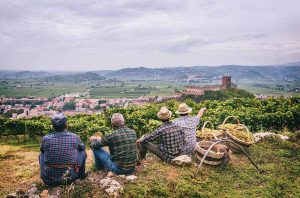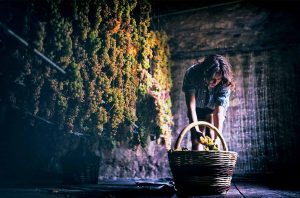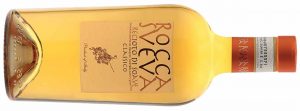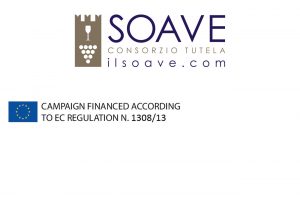It is a rather unique experience to climb up Monte Calvarina, Soave’s highest peak, and experience the gradual and minute changes in soil profile, temperature, humidity and vegetation. The smells of herbs and wildflowers change at each turn of the road, as do the fascinating views over different aspects of the hills and valleys of Soave. Each panorama is a precious snippet of viticultural knowledge – few wine regions provide such a rich geological and cultural journey within the perimeter of but a fraction of its full expanse.
Exploring the Soave DOC is indeed a living lesson through millennia of geological changes, and centuries of cultural and oenological history. It is also an exploration of how humanity can evolve as a true physical and spiritual part of nature, chiselling the landscape while adapting and paying tribute to it – something that the stone walls and ‘capitelli’ (small niches featuring religious figures, dotted around Soave’s roads and fields) are a beautiful reminder of.

Geological dance
Although hard to imagine, 40 million years ago the Soave region, as almost all of northern Italy, was covered by a tropical sea. Tectonic movements and, most importantly, volcanic activity, reshaped the topography and geology of the area to create a complex landscape of limestone-based terroirs (some of which can be traced back to the time of marine submersion) layered with strata of volcanic origin. Broadly speaking, the region is divided in two main geological areas, sectioned by the Castelvetro fault.
This fracture has led to the exposure of different layers on each side, resulting in a predominance of limestone soils to the east and volcanic rocks (basalts and tuffs) to the west. A true understanding of Soave’s geology requires, however, the consideration of other variables: altitude, waterways and erosion have caused the differential exposure of layers and sediment deposition on the valley floors. As such, the limestone and volcanic plains are significantly different from their hilly counterparts.
Ultimately, this creates an intricate and fascinating mosaic of geological profiles which shape a matrix of terroirs of unparalleled complexity, in turn delivering grapes and wines with very different character. Volcanic and east-facing terroirs generally produce steelier wines with a more vertical structure, while limestone and west-facing plots, exposed to the warmer afternoon sun, tend to yield richer, more forward wines. Even within each municipality, terroir diversity is gripping. Because of this granularity, 33 different UGAs (Unitá Geografiche Aggiuntive) were created – based on soil profile, microclimate, altitude and aspect – effectively naming the ‘crus’ of Soave. In official use since 2019, these cover 38% of the total area under vine and represent all of the region’s soil types.
Natural and human balance
If nature and time conspired to create a particularly interesting landscape, men would shape it, taming the challenging slopes (with gradients of up to 80%). Today, the dry stone walls and terraces are an equally important part of Soave’s natural identity; more than mere human constructions, they play a key role in the preservation of the region’s systemic balance and biodiversity by avoiding erosion, preserving soil structure, harbouring insects, and supporting the growth of diverse flora.
The latter is a particularly important factor in the balanced maturation of the grapes and in Soave’s vocation for sustainable practices; olive trees, cherry trees, indigenous herbs, shrubs and woodland grow alongside the vines, moderating temperatures, improving the microbiological health of the soils and sheltering beneficial wildlife that reduces disease pressure by warding off pests. The traditional vine training method, on the other hand, is not only an impactful feature of the scenery, but also has functional importance – especially in the face of climate change.
The pergola veronese, with its atmospheric galleries, provides structural protection to hail, additional shade and more tolerance to drought, therefore promoting longer, balanced ripening and supporting the development of climate resilience. Tale of one grape Soave is synonymous with Garganega, its queen grape, with all wines produced from at least 70% of the local variety, grown in the region for over a thousand years. Kept unchecked, Garganega can overproduce; handled correctly, however, and planted in the right parcels, it can yield fruit of great depth and complexity, very expressive of terroir and vintage.
Soave’s different soils have long provided one of the best habitats for this golden grape, capable of producing age-worthy wines that balance vibrancy with intensity. Naturally high in acid, Garganega retains freshness even when fully ripe, with an aromatic spectrum that ranges from lifted citrus to ripe orchard fruit and fresh nuts. The skins can provide a significant phenolic and tannic charge, an aspect that is being increasingly explored by winemakers to produce textural, food friendly wines. Dinstinctively age-worthy, the best expressions of Garganega can develop beautifully – both in the cellar and in bottle – developing deeper notes of toasted nuts, dried fruit and wildflowers.
Two other grapes – Trebbiano di Soave and Chardonnay – sometimes share the stage with Garganega as blending companions, adding mineral nuances, salinity and textural appeal. But it is Garganega that truly speaks of the Soave lands and history, both in its dry and sweet iterations. Recioto di Soave, produced from raisined grapes, is another example of the collaboration between Man and nature – the best fruit, picked at the right time, and allowed to dry until its aromas are perfectly concentrated, sublimated in wines that are both luscious and fresh.

Looking ahead
Facing future challenges is not only an environmental matter. Although often overlooked, social sustainability is an aspect many wine regions struggle with and which endangers the evolution of the wine industry as much, if not more than, natural changes. Not the case in Soave, where a diverse ecosystem of stakeholders – from small family holdings to bigger corporate structures, by way of leading cooperatives that represent thousands of small growers – has created a cohesive, resilient and creative environment. Together, they reinterpret their shared tradition while seeking a continuous improvement in quality and sustainability, as well as a better understanding of terroir and natural resources.
The balance is also generational; family businesses and cooperatives alike are experiencing steady continuity and evolution, with young, vibrant winemakers and managers coming to the forefront. This human aspect of sustainability makes Soave a region of and for the future, with the confidence of a younger generation eager to experiment while staying true to tradition – an echo of the region’s identity: modern and built upon an awareness of lived experience and empirical, multi-generational knowledge.
The generational and economic diversity is also testament to the trust that growers and winemakers have in each other and in the unique terroir they are privileged to be guardians of. Soave is a place where craftsmanship has been put at the service of terroir to create pure, expressive wines. The next generation of growers and winemakers is ready to renew this commitment, armed with the best tools: passion and knowledge.
Soave at a glance
Located in western Veneto, east of Verona, neighbouring Valpolicella to the southeast Altitude 30 to 550 metres Soil types Basalts, tuffs, limestone and alluvial sediments Production area 6.000 ha Average production 40 M bottles Permitted grape varieties Garganega (minimum 70% in blends) and up to 30% of Trebbiano di Soave (and/or Chardonnay.
One DOC: Soave (also produced in the Classico and Colli Scaligeri sub-areas)
Two DOCGs: Soave Superiore and Recioto di Soave (both of which are also produced in the Classico sub-area)
13 Municipalities: Soave, Monteforte, San Martino Buon Albergo, Lavagno, Mezzane di sotto, Caldiero, Colognola ai Colli, Illasi, Cazzano di Tramigna, San Bonifacio, Roncà, Montecchia di Crosara and San Giovanni Ilarione.
33 UGAs: Castelcerino, Fittà, Tremenalto, Corte del Durlo, Costalunga, Menini, Castellaro, Brognoligo, Costeggiola, Campagnola, Sengialta, Colombara, Foscarino, Carbonare, Rugate, Coste, Monte Grande, Pressoni, Costalta, Casarsa, Pigno, Ponsara, Froscà, Volpare, Tenda, Croce, Zoppega, Ca’ del Vento, Broia, Paradiso, Monte di Colognola, Duello, Roncà – Monte Calvarina.
Soave wines to try
Tasted and scored by the Decanter team

Corte Giacobbe, Runcata, Soave Superiore 2021 94
Very classy Burgundian nose, expressive without losing subtlety. Gentle floral notes mingle with toasted nuts and sweet spice. Flavours of pear, apple and preserved lemon are topped by vanilla and hay. The wood is very well worked, underpinning the structural minerality. Outstanding ageing potential. Alc 13%

Antonio Fattori, Motto Piane, Soave 2020 93
Assertive texture with a firm, very appealing, phenolic grip. Seductive nose defined by nutty intensity and orchard fruit richness. Flavours of dried apple peel, lemon zest, preserved lemon and roasted walnuts, reaffirm the nose’s profile. A wine that will age beautifully, with nutty complexity. Alc 14%

Balestri Valda, Sengialta, Soave Classico 2020 93
Beautiful and fleshy, with a poised yet assertive structure. Lemon zest and yellow apple flavour underpinned by a fine acid line. Delicate nutty quality, very elegant and refined. Lively acidity driving the long finish. Organic certified. Alc 13.5%

Cantina Filippi, Vigne della Brà, Soave Colli Scaligeri 2021 93
Alluring aromas of apple blossom, rose petals, peach and orange peel. The palate surprises with its outstanding texture of white grapefruit and fleshy orchard fruit. Blanched almonds and a delicious, refreshing mineral grain add lift and complexity. Organic certified. Alc 12%

Monteforte, Foscarino, Soave Classico 2021 93
Beautiful, focused expression of Garganega for a quintessentially volcanic wine. The soft but assertive minerality. carries the ripe orchard fruit – greengage, white peach, pear – which is topped by a fine layer of fleur de sel. Delicious.

Suavia, Monte Carbonare, Soave Classico 2021 93
Charming aromatic profile with a strong core of fruit lined by herbal and nutty layers. Burgundian, nutty edge, with honey glazed almonds, lemon curd and a touch of smoke adding allure. Vibrant, acid lift to the finish. Lovely intensity and a great life ahead of it. Organic certified. Alc 12.5%

Cecilia Beretta, Brognoligo, Soave Classico 2021 92
While quite wide on the mid-palate this wine has a firm vertical backbone. Green crunchy apple, fleshy pear and intense citrus shape a palate at once elegant and generous. The mineral depth and fine acid line add vibrancy. Good ageing potential. Alc 13.5%

Corte Moschina, Evaos, Soave 2021 92
Vibrant yet gentle nose, with mineral freshness. Lifted aromas of lime zest, white grapefruit, and green apple, followed by deeper flavours of asian pear, melon and crunchy pineapple. Lovely salinity and zesty grip to the finish. A very gastronomic wine. Alc 13%

Inama, Foscarino, Soave Classico 2021 92
Restrained nose, subtly mineral. The palate is soft and driven by vibrant citrus. Gentle grip, with white grapefruit filling the mid palate and pulling the fleshy grip. Subtle spicy lining to the finish. Interesting development potential. Alc 12.5%

Le Battistelle, Soave Classico 2021 92
Expressive and fresh, with texture but also an inviting softness of fruit. Robust mineral backbone supporting the fleshiness of the palate, with green apple, melon and preserved melon. Firm zesty grip on the long finish. Alc 12.5%

Monte Tondo, Casette Foscarino, Soave Classico 2020 92
There’s a subtle pull to this wine’s intensity with its yellow apple, juicy honeydew melon and lemon zest flavours. Overtones of crunchy glazed almonds and smoke add complexity. Delicious, lingering hint of amaretto on the finish. Alc 13.5%

Rocca Sveva, Castelcerino, Soave Classico 2022 92
Soave’s trademark amaro nose shines in this appealing wine, with orchard fruit flavours topped by delicate notes of chamomile and linden. The refreshing zesty grip of blood orange zest adds freshness and texture. Width on the mid-palate and good persistence. Alc 13%

Vicentini Agostino, Il Casale, Soave Superiore 2020 91
Very fresh, mineral nose. Lovely softness on the palate, with a flinty layer supporting the crunchy orchard fruit. Melon, crunchy pear, yellow apple and white peach mingle with hints of hay and chamomile. Alc 13%
Recioto di Soave

Canoso, Passo, Recioto di Soave Classico 2019 93
The complexity, vibrant acidity and refreshing spiciness of this Recioto make it a real pleasure to drink. The depth of the fruit (nectarine, red apples, cooked pear) and sweetness never overwhelm, perfectly balanced by the delicious salinity and notes of turmeric, nutmeg and cardamom. Alc 14.5%

Corte Moschina, Incanto, Recioto di Soave 2019 92
Two years in oak barriques have lent this recioto a seductive nutty complexity. Vibrant acidity and clementine zestiness balancing the rich red apple and nectarine. Gently savoury, with alluring herbal and vegetal notes (fennel seed, celery, linden). Alc 14.5%

Rocca Sveva, Recioto di Soave 2019 91
Restrained minerality on the nose, with a subtle and elegant aromatic profile. Fresh mandarin, peach, nectarine and rose petals fill the mouth, lifted by a fine acid line. Alc 14.5%
Discover more about Soave
Connect on:
Facebook | Twitter | Instagram | YouTube








